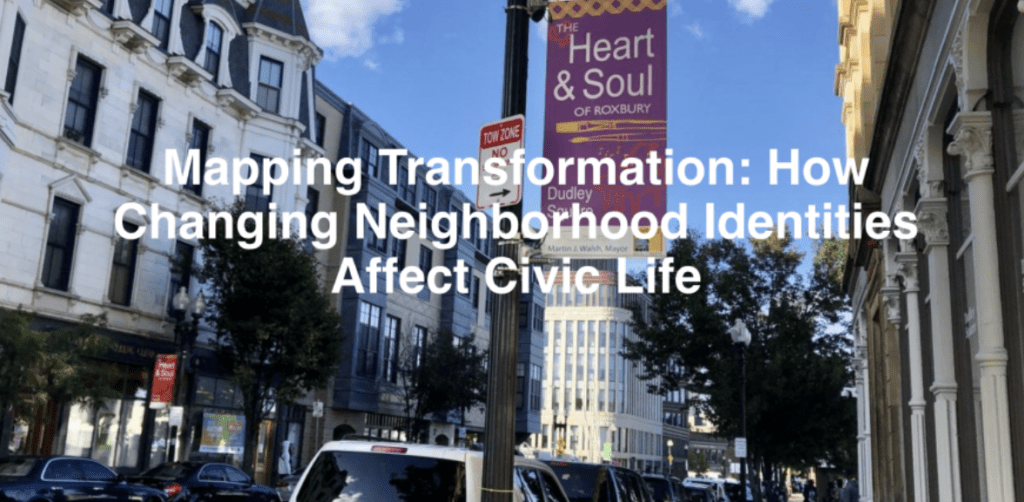On October 28, at a special session of DH Open Office Hours, recipients of NULab Seedling and Travel Grants shared their exciting projects in a round of lightning talks. Weekly DH Open Office Hours are organized by the Digital Scholarship Group. The panelists were Jay Cephas, Assistant Professor of Architecture and Urban Design, Justin Haner, PhD Candidate in Political Science, and Meg Heckman, Assistant Professor of Journalism. NULab Assistant Director Sarah Connell moderated the event.
Jay Cephas began the lightning talks with a presentation on his project, the Black Architects Archive. Cephas is a historian and theorist of city planning and design, and his research explores relationships between technology, identity, and spatial practices. New knowledge in architecture, Cephas explained, involves building on a canon. Despite the prominent work of Black architects in the twentieth century, the architectural canon is predominantly white. Cephas began the Black Architects Archive, whose entries depict the extensive contributions of Black architects, to diversify this canon. The Archive also serves as a public history project, showing the influence of Black architects on the American built environment. Cephas has been compiling the Black Architects Archive through community-driven research; people can contribute information through a web form. So far, Cephas has received a flurry of contributions.
Cephas shared that future work for the Black Architects Archive includes beginning coding for spatial analysis, deepening key partnerships with the National Trust for Historic Preservation and National Museum for African-American History and Culture, and hiring a community-based researcher, sponsored by architectural firms who are interested in collaboration. He plans to publish the Archive in Spring 2021. For his work on the Black Architects Archive, Cephas has also received a Graham Foundation Grant and a Northeastern CAMD Grant for Research on Social Justice and Anti-Racism.
Justin Haner spoke about his research project, “Organizing Europe: An Analysis of Expanding Zones of Common Governance and the Long-Term Decline in European Armed Conflict,” which analyzes long-term trends in armed conflict. Haner’s research question derives from Hugo Grotius’ concept of war, in which war is an alternate choice for achieving foreign policy objectives, after less costly and dangerous options. Using a source base of 70,000 historical treaties, Haner has traced a broad decrease in war in Eastern and Western Europe over time. He has developed a “Theory of Organized Peace,” whereby the UN reduces war in Europe. So far, Haner has processed 20,000 of the treaties in his source base, a task involving translation to twenty-first-century English. Through this project, Haner is continuing to research the factors that are most likely to provoke war.
Meg Heckman discussed Mapping Transformation, a journalistic project for which she served as a faculty advisor. Mapping Transformation is published in The Scope, an editorially independent publication staffed by Northeastern University journalism students. Funded by internal and external grants, The Scope provides a laboratory where journalism students can apply the skills they learn from their coursework. Student writers respond to the information needs of the local community by partnering with local news organizations who cannot afford to hire freelancers. The Source primarily seeks to serve neighborhoods bordering Northeastern University’s campus who are underrepresented in and not often reached by mainstream news.

The graduate students who created the Mapping Transformation project were first inspired by the 2019 decision to change the name of Nubian Square (formerly Dudley Square) in Roxbury. Through a long-form article and interactive maps, the students documented similar name changes, as well as the creation of cultural “districts,” in Boston neighborhoods. Eileen O’Grady, who led the student team, wrote the NULab grant application and administered the project’s budget. The other student journalists were Ruth Hunger, Jordan Erb, and Szu Yu Chen. As the faculty advisor, Heckman helped the team establish a workflow and project management system. She also supervised collaboration between the team and the NULab. Heckman shared the NULab grant also enabled the student team to develop financial and project management skills. She believes these skills are particularly important for young journalists to develop because grants and angel investment are becoming increasingly central in funding journalism projects. Heckman also expressed her interest in facilitating women’s leadership in journalism and her pride in the project’s all-women student team.
A series of audience Q&As concluded the lightning talks. Jay Cephas answered several questions about the Black Architects Archive, elaborating that it began with his interest in creating a visual architecture history that would allow a way to trace the creation of architectural movements. He also clarified that the entries in the Black Architects Archive include architects, firms, and buildings and that they are intended to be a starting point for visitors to conduct their own in-depth research. Justin Haner answered a question about his use of marriage treaties in the project, agreeing that they are important historical documents. Since treaties are so difficult to build, Haner explained, the fact that they exist indicates how important they were to monarchs.
Despite the intellectual depth of this event and the wide range of topics covered, it all occurred in just 45 minutes. Participants enjoyed an engaging opportunity to learn more about the research projects at Northeastern that the NULab helps to fund.
NULab seedling and travel grants are open to Northeastern University faculty and graduate students. During the COVID-19 pandemic, travel grants can be used to cover expenses related to online events. More information about NULab grants can be found on our “Seedling and Travel Grants” page.



